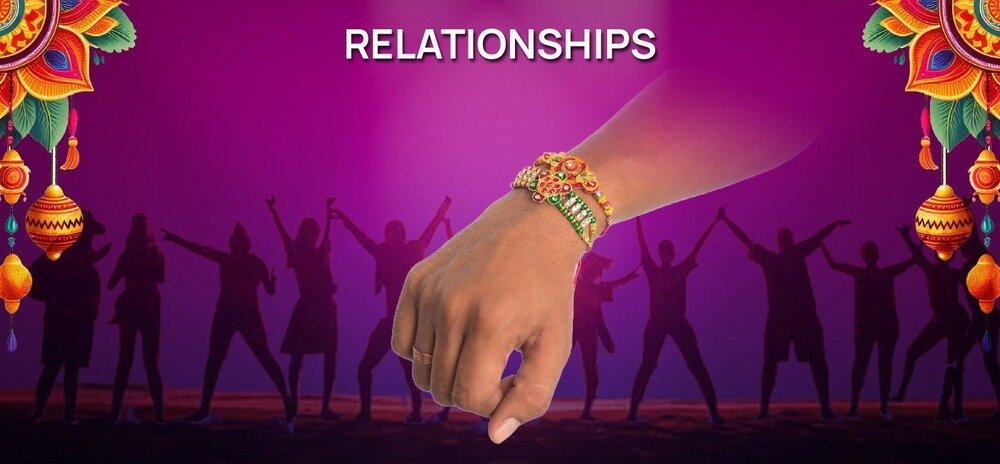“Phoolon ka taaron ka, sabka kehna hai…” The melody instantly transports us to a world of innocence and sibling love. A simple rakhi, a homemade sweet, and a shagun of Rs. 51 as a gift captured the essence of this cherished festival. But times have changed, and so has Raksha Bandhan.
Today, the festival is a dazzling spectacle of traditions and trends—a transformation as dramatic as a Bollywood makeover. Raksha Bandhan has become a bonafide economic powerhouse, with a staggering ₹12,000 crore spent on rakhis alone in 2023 and FMCG sales touching a whopping ₹5,000 crore.
So when and how did this evolution happen? Let’s take a look.

Ancient Roots, Sacred Threads
The roots of Raksha Bandhan run deep in Indian history. References to protective threads can be traced back to the ancient Atharvaveda, where they were used in sacred rituals.
From Goddess Lakshmi tying a rakhi to King Bali to Draupadi sharing a piece of her saree with Lord Krishna, there are countless such stories that transformed the simple act of tying a thread into a profound symbol of love and care.

A Royal Endorsement
Stories of alliances forged and protection sought through the exchange of rakhis are etched in history.
From the strategic diplomacy used by Queen Karnavati seeking help from Emperor Humayun to the tales of Alexander the Great’s wife, Roxana, sending a rakhi to King Porus, the festival has transcended time and borders.

A Symbol of Unity
Even the visionary poet Rabindranath Tagore understood the true symbolism of rakhi. In the early 20th century, amidst the tough struggle for Indian independence, he made use of rakhi as a unifying force.
Tagore recognized the power of this ancient tradition to bridge divides and foster harmony between Hindus and Muslims. His use of rakhi as a symbol of unity was a testament to its ability to transcend religious and social barriers.

Of Raksha Bandhan
Raksha Bandhan, once a simple, heartfelt ritual, has evolved with the changing times. While the spirit of the festival remains pure, its practice has adapted to our fast-paced world.
The shift towards nuclear families and increasing geographical distances between siblings has created new dynamics and technology has revolutionized the way we connect and celebrate. Raksha Bandhan has not been immune to this digital transformation.
Online platforms have emerged as convenient avenues for sending rakhis and gifts, bridging geographical gaps and making the festival accessible to everyone.

The Pandemic Caused
The COVID-19 pandemic posed unprecedented challenges, forcing a drastic shift in the way we celebrated festivals. Raksha Bandhan was no exception.
With lockdowns and travel restrictions in place, physical gatherings became impossible.
The rakhi market took a massive hit, plummeting by 60% in August 2020. The sweet industry also felt the pain, with losses amounting to a hefty ₹5,000 crore.

From Crisis to Opportunity
However, this adversity also gave rise to new opportunities. The festival witnessed a surge in online celebrations, with virtual rakhi tying ceremonies and digital gift exchanges becoming the norm.
E-commerce platforms stepped up to meet the rising demand, offering a wide range of rakhi and gift options. Platforms like Ferns N Petals stepped up to the challenge, experiencing a remarkable 100% growth.
An incredible 10,000 rakhi and gift orders were placed daily, reaching siblings in over 80 countries, from the US and UAE to the UK and Singapore.

A Marketing Bonanza
From luxury fashion houses to confectionery giants, everyone is vying for a share of the Raksha Bandhan pie.
Personalized gifts, themed campaigns, and influencer collaborations are the new norm. . Campaigns like Archies’ “Rishte Jazbaton Ke” and Bajaj Allianz Life’s “#ProtectSeZyadaSupport” are perfect examples.
Luxury Takes Center Stage
The luxury segment has also joined the fray. MIA by Tanishq’s exquisite “Shades of Bhai” silver rakhi collection is a prime example. Celebrity endorsements have added a glamorous touch. Bvlgari’s campaign featuring Arjun and Anshula Kapoor and Sara Ali Khan’s association with Ferrero Rocher are notable examples.

Redefining Rakhsha Bandhan
Raksha Bandhan is no longer restricted to biological siblings. The festival has expanded its embrace to include friends, colleagues, and even oneself.
The concept of self-love and personal growth has found expression through the ritual of tying a rakhi. This inclusive approach reflects the changing dynamics of society and the evolving nature of relationships.

The Future of Raksha Bandhan
Raksha Bandhan has undergone a dramatic transformation. What once was a simple exchange of rakhis and sweets has evolved into a multi-million dollar industry. The coming years promise even more growth, with an estimated 30% annual spike in the market.
Beyond traditional gifts, consumers are seeking hyper-personalized experiences. Textiles, jewelry, sweets, and chocolates are witnessing increased demand.
Technology is also playing a pivotal role. AI-powered innovations like Cadbury’s #CreatingMemoriesNeverClicked, which transforms old memories into tangible keepsakes, are redefining the festival experience.
How useful was this post?
Click on a star to rate it!
Average rating 5 / 5. Vote count: 5
No votes so far! Be the first to rate this post.
I’m Archana R. Chettiar, an experienced content creator with
an affinity for writing on personal finance and other financial content. I
love to write on equity investing, retirement, managing money, and more.
























